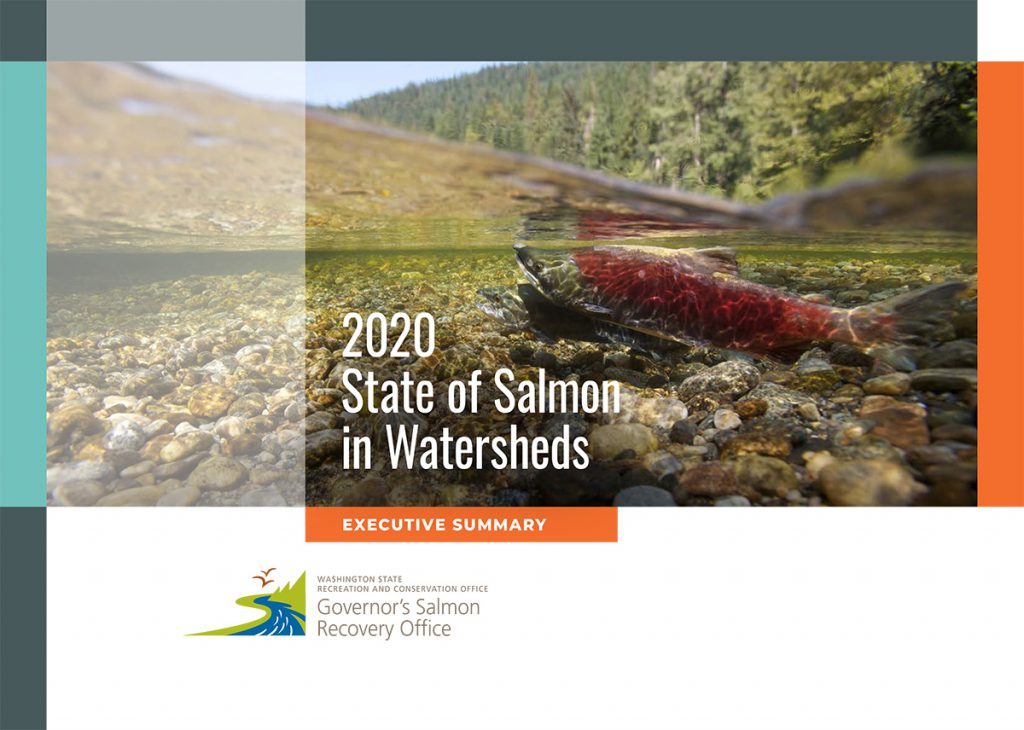THRIVING SPECIES AND FOOD WEB
Statutory Goal: Healthy and sustaining populations of native species in Puget Sound, including a robust food web.
None of the indicators of the Thriving Species and Food Web goal met their 2020 recovery targets and none improved
Species indicators are not making progress toward the targets. None of the indicators have improving trends, with many marine bird species, Southern Resident Killer Whales, and Pacific herring populations declining. There have been recent improvements with certain herring stocks, and Chinook salmon populations are stable but at historic lows.
- Southern Resident killer whales, Pacific herring, marbled murrelets, and scoters are indicator species that continue to decline.
- At best, Chinook salmon populations, the main prey of Southern Resident orcas, have remained stable on the spawning grounds since they were listed under the Endangered Species Act in 1999. Many populations have had slight increases since then, but the margin of error suggests this is not a significant trend toward recovery.
- With only 74 Southern Resident orcas at last count according to the Orca Network, the population is far from reaching the target of 95 whales. However, three whales were born since 2020, the first seen since 2015.
- There have been short-term improvements with certain herring stocks, but the size of all three Pacific herring stocks remains below their baseline levels and target values. However, the year 2020 was exceptional with many more fish on the spawning grounds.
- Marine bird populations have mixed population size trends, with marbled murrelets—an endangered species—and scoters declining, while pigeon guillemot and rhinoceros auklets remain stable.
- The breeding population size of birds living in interior forests has steadily declined since 1968, while human-associated species have remained relatively stable. The declining trend in forest interior species is driven by declines in the golden-crowned kinglet, the most abundant of the three indicator species.
For more details about ecosystem conditions relating to this goal, please see our Story Map on Puget Sound Info.
Climate change exacerbates current stressors on species and food webs
Climate change poses a high risk to most Vital Signs related to Thriving Species and Food Web. Orcas, Chinook salmon, and Pacific herring are at high risk. Birds are at moderate risk (Siemann and Binder 2017).
- reduced quality and availability of Chinook salmon, a primary prey species; and
- ocean warming.
- lower summer flows;
- warming streams;
- earlier peak streamflow;
- higher peak flows; and
- ocean warming and acidification.
- sea level rise and increased shoreline armoring; and
- ocean acidification and reduced availability and quality of forage fish prey.
- changes in availability, quality, and timing of marine bird prey; and
- changes in and loss of forests and other terrestrial habitats.
Signals from the 2020 State of Our Watersheds Report
Blocking Culverts Impact Salmonid Survival: During the first six years of implementing the U.S. v. Washington culvert case injunction, the state of Washington has corrected 150 fish-blocking culverts. At the current rate, if additional support is not gained, the corrections of the remaining 799 culverts would be completed in 32 years (2052).
European Green Crab Threaten Native Species: Between 2016 and 2019, over 360 European green crabs were captured in the Puget Sound Region by Washington Sea Grant, Washington State Department of Fish and Wildlife, tribes, U.S. Fish and Wildlife Service, and partners. Although European green crab occurrences in the Puget Sound region have so far been relatively rare, the impacts of their populations in other parts of the world indicate the potential for widespread changes to Puget Sound’s ecosystem if action is not taken to limit their spread. Green crab are outcompeting juvenile native Dungeness crab for space, increasing the threat to Dungeness crab from predators and decreasing food availability.
Habitat Suitability for Puget Sound Birds
The Stillaguamish Tribe of Indians and Audubon Washington, with support from the PSEMP Marine Birds Work Group, led the development of the Avian Habitat Suitability Models for Puget Sound Estuary Birds. This study provides a scientific basis for integrating birds into estuarine restoration and conservation. Extensive habitat loss and degradation in Puget Sound estuaries has impacted the abundance and distribution of birds that rely on estuarine and coastal habitat. The study identifies valuable information about the environmental conditions that best explain where five “narrative” species are likely to occur and where they are most abundant. For example, wetlands – particularly estuarine emergent wetlands – and mudflats are essential to support native species populations. It also points to specific actions that land managers can take to ensure Puget Sound continues to serve as a vital link for Pacific Flyway birds. The study makes clear recommendations for restoration and monitoring and highlights the need for a regional monitoring framework.
 State of Salmon in Watersheds overview
State of Salmon in Watersheds overview
Every two years the Washington State Recreation and Conservation Office reports on the State of Salmon in Watersheds. This web report provides stories and data about salmon, habitat, and salmon recovery. It documents the collaborative work of state and federal agencies, Indian tribes, regional organizations, and nonprofits to recover salmon and steelhead stream by stream.
The 2020 report describes a wide range of progress toward recovery for 14 species of salmon and steelhead listed as at-risk of extinction under the Endangered Species Act. In Puget Sound, Chinook salmon are in crisis. Summer chum abundance, however, is approaching federal recovery goals in both the Hood Canal and Strait of Juan de Fuca populations.


